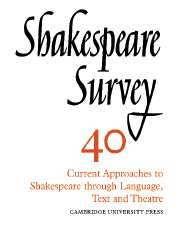Book contents
- Frontmatter
- Reconstructing Shakespeare, or Harlotry in Bardolatry
- Playing Shakespeare
- Take me to your Leda
- Sign Theory and Shakespeare
- Time in Richard III
- New Concepts of Staging A Midsummer Night’s Dream
- Henry V as Working-House of Ideology
- Shakespeare and his Sources: Observations on the Critical History of Julius Caesar
- The Speculative Eye: Problematic Self-Knowledge in Julius Caesar
- Learning by Talking: Conversation in As You Like It
- Measure for Measure: Mirror for Mirror
- Allegory and Irony in Othello
- Cruelty, King Lear and the South African Land Act 1913
- The Rationale of Current Bibliographical Methods: Printing House Studies, Computer-Aided Compositor Studies, and the Use of Statistical Methods
- Shakespeare’s Late Plays at Stratford, Ontario
- Shakespeare Performances in London, Manchester and Stratford-upon-Avon 1985–6
- The Year's Contributions to Shakespearian Study 1 Critical Studies
- 2 Shakespeare’s Life, Times, and Stage
- 3 Editions and Textual Studies
- Index
Sign Theory and Shakespeare
Published online by Cambridge University Press: 28 March 2007
- Frontmatter
- Reconstructing Shakespeare, or Harlotry in Bardolatry
- Playing Shakespeare
- Take me to your Leda
- Sign Theory and Shakespeare
- Time in Richard III
- New Concepts of Staging A Midsummer Night’s Dream
- Henry V as Working-House of Ideology
- Shakespeare and his Sources: Observations on the Critical History of Julius Caesar
- The Speculative Eye: Problematic Self-Knowledge in Julius Caesar
- Learning by Talking: Conversation in As You Like It
- Measure for Measure: Mirror for Mirror
- Allegory and Irony in Othello
- Cruelty, King Lear and the South African Land Act 1913
- The Rationale of Current Bibliographical Methods: Printing House Studies, Computer-Aided Compositor Studies, and the Use of Statistical Methods
- Shakespeare’s Late Plays at Stratford, Ontario
- Shakespeare Performances in London, Manchester and Stratford-upon-Avon 1985–6
- The Year's Contributions to Shakespearian Study 1 Critical Studies
- 2 Shakespeare’s Life, Times, and Stage
- 3 Editions and Textual Studies
- Index
Summary
You will follow my proposals more easily if you begin by acting one line of Shakespeare. You can do it sitting down. The line is Ophelia’s. Women readers will do it naturally; and men can remember that only they would have been allowed to act the part in Shakespeare’s time.
Ophelia, deeply troubled, rushes to her father, to describe Hamlet’s silent, distracted visit to her closet:
He took me by the wrist, and held me hard;
Then goes he to the length of all his arm,
And, with his other hand thus o’er his brow,
He falls to such perusal of my face
As ’a would draw it.
(2.1.87-91)The line I am after is: 'And with his other hand thus o'er his brow .. . ' How 'o'er his brow'? What did he do with his hand? Think about this for a moment, be the distraught Ophelia. Then, please, say the line with accompanying action:
And with his other hand thus o'er his brow . . . .
What you do, of course, is make a sign - a sign Shakespeare required to give an idea of Ophelia's image of Hamlet's distraction. Your sign will be your unique reflection of an emotional state. In a search among the reviews at the Colindale library, my wife, Mary, and I found Tom Taylor's observation of 1873 that Ophelia's usual gesture in the theatre was 'as if to shade the eyes from the light'. Taylor preferred the hand 'pressed hard on the forehead' - a considerable difference: one gesture directed mainly outward, the other inward.
- Type
- Chapter
- Information
- Shakespeare Survey , pp. 33 - 40Publisher: Cambridge University PressPrint publication year: 1988

